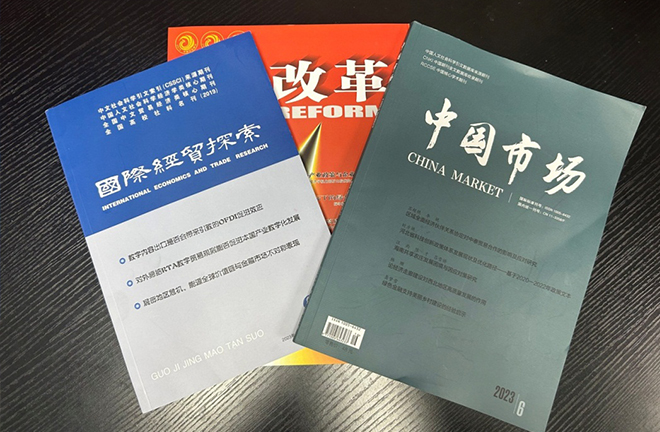Greater Bay Area embraces new opportunities

Journals pertinent to economic and trade development Photo: Yang Lanlan/CSST
Recently, the State Council approved comprehensive development plans for the Guangdong-Macao in-depth cooperation zone on Hengqin Island, Zhuhai (Hengqin Plan), and the Qianhai Shenzhen-Hong Kong Modern Service Industry Cooperation Zone (Qianhai Plan). These plans hold significant importance for the establishment of major cooperation platforms within the Guangdong-Hong Kong-Macao Greater Bay Area (GBA).
The Institute of Free Trade Zones at Sun Yat-sen University (SYSU) held a symposium in Guangzhou, Guangdong Province, in late December 2023, interpreting the highlights of the Hengqin and Qianhai plans and the future orientation of the GBA.
Respective focuses
The Hengqin and Qianhai plans each has their own distinct focus. Xiao Jincheng, a research fellow from the Chinese Academy of Macroeconomic Research and chairman of the China Society of Territorial Economists, explained that the Hengqin Plan aims to enhance trade facilitation and promote industrial development in Hengqin and Macao, based on the principles of “inside the national border but outside the customs territory” and “free flow through the first line and control at the second line.”
The Qianhai Plan places greater emphasis on the high-level opening up of the service industry, particularly the financial sector, the internationalization of RMB, and the marketization of interest rates, Xiao added. Another highlight of the plan is the clear functional division of administrative districts and economic zones in Qianhai. This serves to clarify the rights and responsibilities of the two sides and mitigate market segmentation resulting from administrative barriers.
According to Wang Xiaohong, a senior research fellow at the China Center for International Economic Exchanges, the two plans exemplify the strategic positioning of supporting Hong Kong and Macao to integrate into the overall national development, in line with the new development stage, concept, and pattern. They signify the essence of a new phase of high-level opening up, namely, institutional opening up.
Zhao Fujun, director of the comprehensive research office of the foreign economic research department at the Development Research Center of the State Council, has identified the policy and institutional innovation of the Qianhai Shenzhen-Hong Kong Modern Service Industry Cooperation Zone as embodying “five highlights:” efficient new systems for the modern service industry, the high-standard construction of the Qianhai Shenzhen-Hong Kong International Legal Services District, the establishment of a high-end innovation base, the creation of a high-quality international living circle, and compliance with high-standard economic and trade rules, including the Comprehensive and Progressive Agreement for Trans-Pacific Partnership (CPTPP) and the Digital Economy Partnership Agreement (DEPA).
Regarding policy and institutional innovation, the Guangdong-Macao in-depth cooperation zone on Hengqin Island also features “five highlights,” as outlined by Zhao: the advancement of scientific and technological research and high-end manufacturing, the enhancement of international high-level medical services, the establishment of a new system for high-level opening up integrating Macao, the creation of an efficient and convenient government environment, and the initiation of high-level opening up stress tests in line with CPTPP and DEPA.
Role of connection
In the GBA blueprint, Hengqin is linked with Macao, Qianhai with Hong Kong, and Nansha District in Guangzhou is oriented towards the international community. Li Shanmin, chairman of the Institute of Free Trade Zones at SYSU, said that Qianhai and Hengqin aim to leverage their respective advantageous industries and facilitate the comprehensive integration with the rules, regulations, and standards of Hong Kong and Macao. Meanwhile, Hong Kong and Macao are tasked with the role of being “super contacts” to link the resources of ASEAN countries, developed countries in Europe, the United States, and Portuguese-speaking countries to the three areas, serving as the primary option for “going out” and “bringing in.” These efforts help drive the convergence of domestic and international markets and resources in the GBA, thereby establishing a new growth pole within the global economy.
The two plans have provided clear directives for the future development of Hengqin and Qianhai, said Fu Zhengping, dean of the Institute of Free Trade Zones at SYSU. As integral parts of the Guangdong Pilot Free Trade Zone, Hengqin and Qianhai are mandated to further advance the high-level opening up of the service industry through institutional innovation and enhance the function of stress testing.
The plans have charted the course for Qianhai and Hengqin to fully unleash the potential of openness, concluded Lin Jiang, a professor with the Lingnan College at SYSU. Simultaneously, Guangdong-Macao cooperation within the Hengqin framework should also involve Hong Kong. The deep integration of Hong Kong and Macao aligns the two special administrative regions with the overall national development.
Edited by YANG LANLAN
